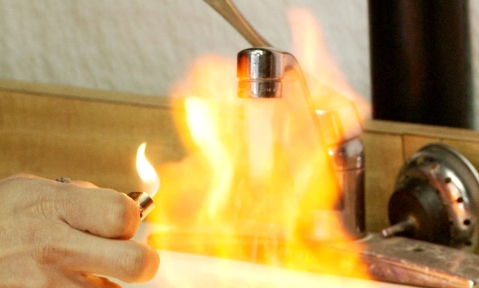Fracking in L.A.? (Workshops to be held on 6/12 and 6/13)
June 11, 2012 § 2 Comments

A Dimock, Pennsylvania resident lights their flowing tap on fire, a result of natural gas drilling and hydraulic fracturing in a nearby field. While such effects may not occur as a result of petroleum well fracking, the shock-value of this image underscores the potential for groundwater contamination in any circumstance. (SOURCE: http://www.gaslandthemovie.com)
It is likely that many folks living in Los Angeles County are either entirely unfamiliar with hydraulic fracturing (fracking for short) or are under the impression it occurs only in distant places such as the Appalachian Basin (Marcellus Shale). This resource extraction process utilizes the high-pressure injection of thousands (and in some cases, millions) of gallons of water, sand and a proprietary blend of up to 600 chemicals (potentially including known carcinogens such as lead, uranium, mercury, ethylene glycol, radium, methanol, hydrochloric acid and/or formaldehyde) into deep wells to open fissures that enable natural gas to flow more freely out of the well. While the practice is primarily associated with the natural gas industry, fracking is also a method used by the petroleum industry as a means of squeezing more production out of what were previously thought to be exhausted wells.

Diagram illustrating the process behind hydraulic fracturing and, yes, the blue strip in the middle of the image represents an aquifer. (SOURCE: http://www.gaslandthemovie.com)
For the vast majority of Angelenos, it might come as a surprise to find out that there are two local petroleum wells, VIC-1-330 (Baldwin Hills, Plains Exploration & Production Company) and DOM-1 (Dominguez Hills, Occidental Oil and Gas), that have been fracked as recently as January of this year (SOURCE: FracFocus) and according to a recent report by Christine Shearer of Truthout, fracking has occurred in the L.A. basin for some time:
In 2006, noxious fumes – methane gas and hydrogen sulfide – leaked out from deep drilling sites in two separate incidents, forcing home evacuations. That was when many residents discovered that oil and gas company Plains Exploration & Production Company (PXP), using 3-D imaging to discover where crude oil remained in the state, had ramped up drilling on the field – and near homes – in 2004. After going through various documents, residents found that, in addition to drilling as deep as 10,000 feet, the company was also employing fracking to access the oil. (Shearer, Christine. Fracking in California Raises New and Old Concerns. truth-out.org, May 30, 2012)

A current map of areas where hydraulic fracturing has been employed by the natural gas and petroleum industries. (SOURCE: http://www.gaslandthemovie.com)
The negative side effects of fracking have been famously documented in the film Gasland, the most shocking being the ability of Pennsylvania residents to light their tap water on fire as it runs from the faucet. Because fracking often reaches depths below local aquifers, the potential for groundwater contamination is a very real concern. See below for an incredibly lengthy list of chemicals that, according to FracFocus, are routinely used in hydraulic fracturing (FracFocus is the national hydraulic fracturing chemical registry, an organization that is managed by the Ground Water Protection Council and Interstate Oil and Gas Compact Commission; for context, the latter organization, the IOGCC, is reported by ProPublica to have state representatives who are either industry lobbyists or energy executives). Add into the equation that fracking itself requires a massive volume of water (in some cases up to 8 million gallons per frack) that is purposely contaminated and transported considerable distances to well sites by diesel tanker trucks and the cumulative impacts of fracking become clear. Another concern particularly pertinent to L.A. residents is the potential link between fracking and the increased frequency of earthquakes.
The California Department of Conservation is hosting a series of workshops on the hydraulic fracturing at the following locations:
- CULVER CITY: 6/12 (tomorrow), 7-9 pm, (City Council chambers, 9770 Culver Boulevard, Culver City, CA 90232)
- LONG BEACH: 6/13 (Wednesday), 7-9pm, (Calif. State University-Long Beach Student Union, 1212 N. Bellflower Blvd., Long Beach, CA 90815)
According to the Department of Conservation, “these workshops are to be conducted as part of a comprehensive information gathering process aimed at the development of regulations governing hydraulic fracturing.” As with most regulation, the conversation is heavily dictated by semantics (e.g. L.A. River navigability). The current debate surrounding fracking in California centers around whether the practice is classified as an “underground injection” technique or a “well stimulation” practice. The simple difference in terminology has huge implications, for if fracking is considered a “well stimulation” practice, it will be exempt from EPA oversight (since 2005, fracking has been exempt from the Safe Drinking Water Act as well). This should be on the radars of Creak Freaks across the state.
RESOURCES:
- Dangers of Fracking: Elegantly presented website outlining the basics of hydraulic fracturing
- Gasland: Film documenting the use of fracking in natural gas extraction.
- FracFocus: Hydraulic fracturing chemical “disclosure” registry (includes a search function for local wells)
- California Department of Conservation
- California Division of Oil, Gas, and Geothermal Resources (DOGGR) Fact Sheet
- Let’s Close the information gap about fracking (L.A. Times)
- Fracking in California Raises New and Old Concerns (Truthout)

A list of chemicals typically included in fracking fluid. Omitted from the list are compounds such as lead, mercury, uranium and formaldehyde, all of which have been previously found in fracking fluid mixes. (SOURCE: fracfocus.org, dangersoffracking.com)

Fracking is being done in Baldwin Hills with virtually no public or government oversight, directly into the dangerous and active Newport-Inglewood Fault Zone.
The non-profit Food and Water Watch is helping with a campaign to ban fracking in California.
Thanks Matt! I had meant to link to the Food & Water Watch campaign in the post but neglected to do so. More information can be found HERE.